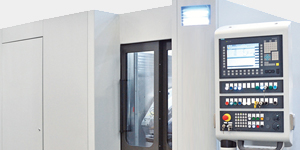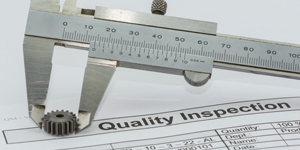Since the 1980s, the oxygen (carbon) probe has become a mainstay in steel heat treating, providing accurate and real-time monitoring of furnace atmosphere used for neutral hardening or carburizing steel. In this column, I will discuss the oxygen (carbon) probe that has become so widely used in the steel heat-treating industry.
Introduction
An oxygen probe or carbon probe consists of platinum electrodes separated by an yttrium-doped zirconia tube. The probe is inserted into the furnace or generator. An air supply of approximately 0.5 CFH of air is supplied to the probe as a reference. The differential oxygen partial pressure between the furnace atmosphere and the reference atmosphere sets up a voltage across the probe. By measuring this small voltage (measured in millivolts), the carbon potential can be determined. Thus, the furnace atmosphere carbon potential can be controlled by air and natural gas additions by monitoring the voltage potential across the probe. In modern instruments, this is done internally using microprocessors. In many ways, it operates in a similar fashion to the O2 sensor in a car for proper combustion.
The principal advantage of an oxygen probe is that it is accurate and fast. A direct read-out of the carbon potential of the atmosphere is common. The probe has a high temperature range, suitable for high-temperature carburizing. Little maintenance is required.
History of the Oxygen Probe
The invention of the oxygen probe in the 1980s marked a turning point, offering solutions that were both cost-effective and highly responsive. Manufacturers pioneered in-situ analyzers capable of instantly detecting atmospheric changes, eliminating delays associated with sampling. Innovations in probe design, such as the use of robust alloys and improved electrode bonding, increased service life and minimized maintenance related to soot or carbon buildup [1].
Simultaneous advances in electronic instrumentation and microprocessor technology made it possible for the probe to deliver signals to microprocessor controllers, which could automatically adjust gas flows and maintain stable furnace atmospheres. By the mid-to-late 1980s, the oxygen (carbon) probe became widely adopted in heat-treating facilities for carburizing and neutral hardening [2].

There have been numerous patents filed regarding oxygen probes, and their improvement. One of the first patents using a zirconia and calcium oxide probe, was patented by William Hickam at Westinghouse Electric Corporation in 1967 [3]. This patent was originally filed in May 1963. Another patent, regarding the measurement of the oxygen potential at high temperatures using a zirconia and magnesium oxide and platinum-rhodium electrodes, was patented July 8, 1969, by Douglas L. Davies, GKN Group as assignor [4].
An improved oxygen probe was described by Donald Sayles of Westinghouse Electric Corporation for the direct monitoring of oxygen concentration [5]. This probe design used reference air, and an internal thermocouple to accurately determine conditions in the furnace. An alternative construction was proposed by Banister et al [6].
A modern design probe was patented by Blumenthal and Melville in 1986 [7]. This probe design has become the basis for many other oxygen probes [8]. There are many other patents regarding oxygen probes, but these are the most significant ones.
Mechanism of Operation
Endothermic atmospheres are commonly used during the heat treatment of steel. It is used as a carrier gas for atmosphere additions for carburizing or carbonitriding. Using an endothermic generator, either natural gas or propane is used. If nitrogen-methanol is injected into the furnace, then methanol is the carbon source.
All these methods produce an atmosphere containing CO and H2. Nitrogen appears because it is either from the atmosphere in the case of endothermic generators, or as a carrier gas in the case of nitrogen-methanol atmospheres. The nominal composition of the gas produced using these methods is shown in Table 1. The difference in the amount of CO produced using the different methods is very important, as this value is used to determine the carbon potential in the carbon controller.
The equilibrium composition of the gas depends on the water gas reaction (Equation 1):

This means that there are four gas species that can be used for proper control of the atmosphere. Practically, there are only two reactions available for control (Equations 2 and 3):

These two reactions are combined into the water gas reaction above. From these last two reactions, that means that we can control the furnace atmosphere by monitoring and controlling the oxygen potential between the two reactions (Equation 4):

An oxygen probe used in the heat treatment of steel works by the electrochemical principle, primarily using a zirconia (ZrO2) element that conducts oxygen ions at high temperatures (above 550°C). The probe measures the difference in oxygen concentration between the furnace atmosphere and a known reference air supply, generating a voltage signal that is proportional to the oxygen partial pressure in the furnace.
In an oxygen probe, oxygen molecules at the electrode with higher oxygen concentration (reference) dissociate, gain electrons, and form oxygen ions (O2-). These ions migrate through the zirconia toward the electrode with lower oxygen concentration (furnace atmosphere), where they release electrons and revert to oxygen molecules. As a result, an electromotive force (EMF) is generated across the electrodes, its magnitude determined by the Nernst equation (Equation 5):

Where E is potential difference (volts); R is the universal gas constant (8.314 J mol-1 K-1); T is absolute temperature (Kelvin); F is Faraday constant (96484 coulomb mol-1); and P1 and P2 are the partial pressures of oxygen on each side of the probe. The voltage produced by the oxygen probe is proportional to the difference in oxygen partial pressures inside the furnace and the reference chamber.
The probe signal is processed by furnaces’ atmosphere controllers to calculate the carbon potential of the furnace atmosphere. In general, the carbon content is inversely related to the square root of the partial pressure of oxygen. This again assumes that the CO content of the atmosphere is constant, and at approximately 20% (23% for propane-generated atmospheres).
This is the primary disadvantage of the oxygen probe, in that it assumes a fixed CO content (typically either 20% for natural gas or 23% for propane). If the CO content is not at this fixed value, then the readings obtained by the probe are erroneous. The carbon content indicated must be verified, and the gas composition checked at routine intervals [1]. The oxygen probe is also a ceramic tube, and prone to thermal or mechanical shock. It must be routinely replaced at roughly yearly intervals, depending on the application. Heavy carburizing can shorten the life of the probe. However, the accuracy, ease of use, and lack of maintenance, generally outweigh the disadvantages.
Conclusion
In this article, I have discussed the history of the oxygen (carbon) probe, and the general construction. Further, we have covered the electrochemical nature of the oxygen probe and have given an overall view of the principal of operation.
Should there be any questions or comments regarding this article, or suggestions for further articles, please contact the writer or editor.
References
- A. Muhlenkamp, “Carbon potential verification,” Thermal Processing, no. May/June, pp. 26-28, 2018.
- K. Nagata and K. S. Goto, “Recent development and future of chemical sensors for high temperature use,” Materials Sciience and Engineering: A, vol. 146, no. 1-2, pp. 63-79, 1991.
- W. M. Hickam, “Device for Monitoring Oxygen Content of Gases”. United States of America Patent 3,347,767, 17 October 1967.
- D. W. Davies, “Apparatus for Measurement of Oxygen Potential of Gases at High Temperatures”. USA Patent 3,454,486, 8 July 1969.
- D. A. Sayles, “Device for Oxygen Measurement”. United States of America Patent 3,546,086, 8 December 1970.
- M. J. Banister, G. Waverley, N. A. McKinnon and R. R. Hughan, “Oxygen Sensors”. United States of America Patent 4,193,857, 18 March 1980.
- R. N. Blumenthal and A. T. Melville, “Hot Gas Measuring Device”. United States of America Patent 4,588,493, 13 May 1986.
- W. Goehring, M. Roggatz and B. Edenhofer, “Oxygen Probe for Heat Treatment”. Germany Patent DE3833968A1, 12 April 1990.






















